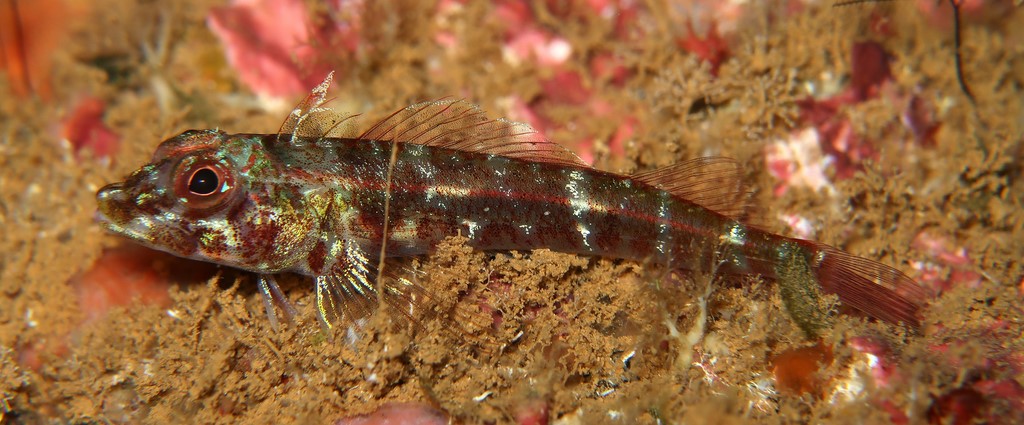HELCOGRAMMA CHICA - (ROSENBLATT, 1960)
Picture courtesy of: Alain Daoulas
Actinopterygii (Gigaclass) > Actinopteri (Class) > Teleostei (Subclass) > Blenniiformes (Order) > Blennioidei (Suborder) > Tripterygiidae (Family) > Tripterygiinae (Subfamily) > Helcogramma (Genus)
Little hooded triplefin, 奇卡弯线鳚,
Description
First dorsal spines: 3; Dorsal spines (total): 13-15 (usually: 14-15); Dorsal soft rays (total): 9-12 (usually: 9-10); Anal spines: 1; Anal soft rays: 18-20 (mean varying with locality); Pectoral fin rays: 14-16; Orbital tentacle absent; Cephalic sensory pores moderately complex; Mandibular pore series: 3-4 + 1 + 3-4; Lateral-line pored scales: 18-23 (mean varying with locality); Lateral line ending under 16th-19th dorsal-fin elements; Nape naked; Upper jaw: 9.8-12.1 % SL, ending below anterior half of eye. Max. length: 3.1 cm SL. Depth range: 0 - 32 m, usually: 0 - 10 m.
Color
Males greater than 20.0 mm SL with dark facial pigment that covers chin and ends abruptly between isthmus and pelvic-fin base.
Etymology
Helcogramma: etymology not explained, perhaps from Greek, helcium = a yoke or collar (harness around the neck of draft animals) + from Greek, gramma = a letter, any writing, a document or record a note of hand, bill, bond, account, written acknowledgement of a debt a letter, an epistle the sacred writings. Possibly referring to lateral line of Helcogramma decurrens, which differs from that of Tripterygion by running “downwards from the shoulder to the middle of the side instead of extending backward parallel with the back”. This unusual lateral line running down the neck may have reminded McCulloch & Waite of that type of equipment, which was still in use when the genus was described.
chica: from Spanish, chica = little. Referring to small size (15.1 mm SL) at maturity.
Original description: Helcogramma chica Rosenblatt, 1960 - Type locality: Ocean Reef, Hull Island, Phoenix Islands.
Distribution
Eastern Indian Ocean, western Pacific: Andaman Sea, Christmas and Cocos-Keeling islands; Papua New Guinea, New Caledonai east to Marshall Islands, Wake Island, and north to Guam and Ogasawara Islands (Japan).
Biology
Adults inhabit surge zones of exposed reefs, on rock surfaces and under ledges. Eggs are hemispherical and covered with numerous sticky threads that anchor them in the algae on the nesting sites. Larvae are planktonic which occur primarily in shallow, nearshore waters.
Similar species
Helcogramma alkamr (Holleman, 2007) - Reported from Western Indian Ocean: East Africa, Persian Gulf and Madagascar east to western India.
Helcogramma serendip (Holleman, 2007) - Reported from Indian Ocean: Sri Lanka.
Last update: 26, June 2022
Actinopterygii (Gigaclass) > Actinopteri (Class) > Teleostei (Subclass) > Blenniiformes (Order) > Blennioidei (Suborder) > Tripterygiidae (Family) > Tripterygiinae (Subfamily) > Helcogramma (Genus)
Little hooded triplefin, 奇卡弯线鳚,
Description
First dorsal spines: 3; Dorsal spines (total): 13-15 (usually: 14-15); Dorsal soft rays (total): 9-12 (usually: 9-10); Anal spines: 1; Anal soft rays: 18-20 (mean varying with locality); Pectoral fin rays: 14-16; Orbital tentacle absent; Cephalic sensory pores moderately complex; Mandibular pore series: 3-4 + 1 + 3-4; Lateral-line pored scales: 18-23 (mean varying with locality); Lateral line ending under 16th-19th dorsal-fin elements; Nape naked; Upper jaw: 9.8-12.1 % SL, ending below anterior half of eye. Max. length: 3.1 cm SL. Depth range: 0 - 32 m, usually: 0 - 10 m.
Color
Males greater than 20.0 mm SL with dark facial pigment that covers chin and ends abruptly between isthmus and pelvic-fin base.
Etymology
Helcogramma: etymology not explained, perhaps from Greek, helcium = a yoke or collar (harness around the neck of draft animals) + from Greek, gramma = a letter, any writing, a document or record a note of hand, bill, bond, account, written acknowledgement of a debt a letter, an epistle the sacred writings. Possibly referring to lateral line of Helcogramma decurrens, which differs from that of Tripterygion by running “downwards from the shoulder to the middle of the side instead of extending backward parallel with the back”. This unusual lateral line running down the neck may have reminded McCulloch & Waite of that type of equipment, which was still in use when the genus was described.
chica: from Spanish, chica = little. Referring to small size (15.1 mm SL) at maturity.
Original description: Helcogramma chica Rosenblatt, 1960 - Type locality: Ocean Reef, Hull Island, Phoenix Islands.
Distribution
Eastern Indian Ocean, western Pacific: Andaman Sea, Christmas and Cocos-Keeling islands; Papua New Guinea, New Caledonai east to Marshall Islands, Wake Island, and north to Guam and Ogasawara Islands (Japan).
Biology
Adults inhabit surge zones of exposed reefs, on rock surfaces and under ledges. Eggs are hemispherical and covered with numerous sticky threads that anchor them in the algae on the nesting sites. Larvae are planktonic which occur primarily in shallow, nearshore waters.
Similar species
Helcogramma alkamr (Holleman, 2007) - Reported from Western Indian Ocean: East Africa, Persian Gulf and Madagascar east to western India.
Helcogramma serendip (Holleman, 2007) - Reported from Indian Ocean: Sri Lanka.
Last update: 26, June 2022
